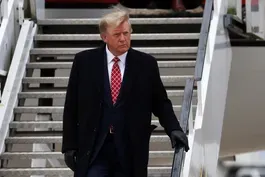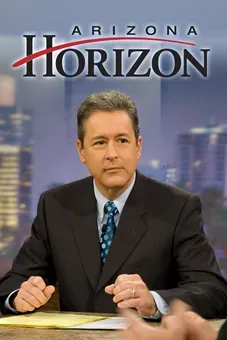
A look at the rise of the AR-15 in America
Clip: 5/8/2023 | 8m 38sVideo has Closed Captions
A look at the rise of the AR-15 in America after 8 killed at Texas outlet mall
AR-15s, like the one used to kill eight people at a shopping mall in Allen, Texas, have become more popular around the country. The rifles have been involved in ten of the country’s 17 deadliest mass shootings. The Washington Post spent months examining the rise of the AR-15 in America and the politics and culture surrounding it. Geoff Bennett discussed that series with reporter Todd Frankel.
Problems with Closed Captions? Closed Captioning Feedback
Problems with Closed Captions? Closed Captioning Feedback
Major corporate funding for the PBS News Hour is provided by BDO, BNSF, Consumer Cellular, American Cruise Lines, and Raymond James. Funding for the PBS NewsHour Weekend is provided by...

A look at the rise of the AR-15 in America
Clip: 5/8/2023 | 8m 38sVideo has Closed Captions
AR-15s, like the one used to kill eight people at a shopping mall in Allen, Texas, have become more popular around the country. The rifles have been involved in ten of the country’s 17 deadliest mass shootings. The Washington Post spent months examining the rise of the AR-15 in America and the politics and culture surrounding it. Geoff Bennett discussed that series with reporter Todd Frankel.
Problems with Closed Captions? Closed Captioning Feedback
How to Watch PBS News Hour
PBS News Hour is available to stream on pbs.org and the free PBS App, available on iPhone, Apple TV, Android TV, Android smartphones, Amazon Fire TV, Amazon Fire Tablet, Roku, Samsung Smart TV, and Vizio.
Providing Support for PBS.org
Learn Moreabout PBS online sponsorshipAMNA NAWAZ: Welcome to the "NewsHour."
Investigators in Texas are still looking for motives in two mass killings this weekend.
In one, a gunman north of Dallas killed eight people before police killed him.
GEOFF BENNETT: In the other, a man driving an SUV plowed into people waiting for a bus in Brownsville.
The impact killed at least eight people and critically injured several more.
FELIX SAUCEDA, Brownsville, Texas, Police Chief: Good morning, everyone.
Thank you all for showing up.
GEOFF BENNETT: Tonight, new details on the deadly collision in Brownsville, Texas, police identifying the driver and revealing his long criminal record.
FELIX SAUCEDA: George Alvarez is a Brownsville local with an extensive rap sheet.
He has been formally charged and arraigned with eight counts of manslaughter, 10 counts of aggravated assault with a deadly weapon.
GEOFF BENNETT: It happened Sunday morning when Alvarez ran a red light and struck 18 people waiting at a bus stop outside a migrant center.
He tried to flee, but was stopped by others at the scene.
Authorities say they are waiting on a toxicology report.
The FBI is working to determine if the crash was intentional.
An eyewitness claims Alvarez yelled anti-immigrant slurs to the men at the bus stop, which police could not confirm.
Police say all of the victims were men, many from Venezuela.
FELIX SAUCEDA: We are working with the Venezuelan government right now, and we have also reached out to other embassies.
GEOFF BENNETT: The region has seen an influx of migrants crossing the border in recent weeks.
MAN (through translator): We hope they will recover because they have families far away who count on them.
We crossed mountains, marched, and past migration.
It was a long way to come here, and we fought hard.
GEOFF BENNETT: While the Brownsville community dealt with the devastation, Texas was already reeling from another tragedy that struck just hours before.
A gunman opened fire at a crowded outlet mall in Allen, Texas, Saturday evening, killing at least eight people.
A police officer already on the scene fatally shot the gunman.
Authorities have not released a motive, as the investigation continues.
GOV.
GREG ABBOTT (R-TX): I believe, in the coming days, the public will be much better informed about why and how this happened, and that will inform us as Texas leaders about next steps to take to try and prevent crimes like this from taking place in the future.
GEOFF BENNETT: According to an Army spokesperson, the gunman entered the Army in 2008, but was terminated three months later without completing training.
Officials report it was for an unspecified mental health condition.
Police say they are examining racist social media posts they say belonged to the gunman.
He was also wearing an insignia on his clothing with an acronym popular with right-wing extremists.
The community mourned the loss at a vigil last night.
KEN FULK, Mayor of Allen, Texas: We are in shock and are all grieving together.
As the healing begins, we will recover.
We will not let the actions of one individual impact our resolve.
GEOFF BENNETT: And, this morning, demonstrators gathered at the Texas House of Representatives to demand action on a proposed gun control measure.
Frequent shootings across the country have put mass killings on a record pace so far this year.
(SINGING) GEOFF BENNETT: For years, Texas lawmakers have rejected tougher gun restrictions.
But, today, a Texas House panel voted to raise the minimum age to purchase an AR-style semi automatic rifle from 18 to 21.
It still faces long odds to pass the full legislature.
AR-15s, like the one used in Allen, Texas, have only become more popular around the country.
And, more and more, they have been used in mass killing since the Sandy Hook massacre in 2012.
In fact, AR-15s have been involved in 10 of the country's 17 deadliest mass shootings.
The Washington Post spent months examining the rise of the AR-15 in America and the politics and culture surrounding it.
Todd Frankel is an enterprise reporter for The Washington Post and was part of that series.
He joins me now.
Thanks for being with us.
And, Todd, as investigators examine the ideology of this Texas gunman and piece together other details, one thing we do know is that he used an AR-15-style assault rifle.
Many of the worst massacres in this country's recent history have the AR-15 in common.
Based on your reporting, why is that?
TODD FRANKEL, The Washington Post: Some of these shooters have manifestos they leave behind and where they explicitly say that they chose the AR-15 because it's especially deadly.
The gun was designed as a military weapon.
And that's its attraction.
It is incredibly powerful.
It shoots a very fast bullet.
It can carry ammo up to 30 rounds without reloading.
And so it is a very effective killing machine.
And, unfortunately, all these mass killers are looking for a tool just like that.
GEOFF BENNETT: The American public has rarely seen the carnage stemming from AR-15s.
As you point out in your reporting, oftentimes, it's because the crime scene photos are considered too gruesome to publish.
What does an AR-15 do to its victims?
TODD FRANKEL: Yes, an AR-15 shoots a very small, but very powerful, very fast bullet.
So, when it strikes the human body, there's a sort of a blast effect that happens once it goes into a body and incredible damage to the internal organs, to the bones.
Compare that to what happens with a 9-millimeter, a typical round that's fired from a handgun.
And that will more likely go through and -- through a body without causing the same sort of internal injuries.
And so we did an animation sort of comparing the two, and it sounds crazy to say it, but you would actually much rather be shot by a handgun with a 9-millimeter round than an AR-15 round.
And we hear this from trauma surgeons about the devastating injuries they see from AR-15s in particular.
It's a different sort of weapon.
It's not the same as being shot by a handgun.
GEOFF BENNETT: Can we talk about the history of the weapon?
Because the family of its creator, Eugene Stoner, said years ago that he never intended the gun for civilian use and that he never owned one himself.
And when the gun first hit the market, the NRA and other gun rights groups, they were suspicious of it and didn't support it.
They didn't want it at their trade shows.
What changed?
TODD FRANKEL: Yes, the AR-15 was designed, as you said, by Eugene Stoner, and he designed it for the military.
That was the market he had in mind.
And, eventually, a lot of guns move their way from the military into the commercial or consumer market.
But you're right.
After the assault weapons ban expired here in the U.S. in 2004, gun companies were wary of the AR-15.
They saw it as a weapon for -- of war, quite frankly.
And so they didn't really want to make it.
But, eventually, they saw there was demand, and they followed that demand on the market and started to produce it.
But it was a -- it was a thing where everyone was very wary about mass-producing this sort of weapon for the public.
GEOFF BENNETT: Well, now it seems the AR-15 is caught in this cycle.
The more it's used in high-profile mass shootings, the more calls there are to ban it.
And the more calls there are to ban it, the more popular it becomes and the more people try to buy it.
And the more people buy it, the harder it becomes to actually regulate it.
Do you see it that way?
TODD FRANKEL: Yes, the problem that a lot of gun proponents will point out is that there's so many of those of those -- of these guns out there now.
The AR-15 is the bestselling rifle in America, which is sort of stunning, if you think as America being a country of hunting rifles like your grandfather's wood stock hunting rifle.
We're no longer that country.
We are a country of AR-15s.
That is the most popular rifle in America.
And so trying to change policy would be very difficult, but there was a 10-year period in the U.S. from 94 to 2004 where assault weapons were banned.
And we made it through that period.
And so there's different ways to look at this problem.
But it's certainly become much more difficult to deal with the longer it's gone on.
GEOFF BENNETT: How did the AR-15 become such an important part of the cultural identity of a certain group of gun owners in this country?
TODD FRANKEL: Part of that was marketing.
And part of that was sort of the imagery we saw in sort of the post-2004 period, when we had images coming back from Afghanistan and Iraq of soldiers coming back.
It was the weapon that was banned.
And so it -- there was this idea that, if you were to own the libs, as they would say, you would you want to own an AR-15.
It was the hated gun.
It's the assault weapon.
And so to make a political point, one side saw that they can score some points by seizing onto this weapon.
And it's a gun that, as a symbol, is very powerful.
Just the outline of it sort of sends a message.
It's sort of replaced the musket as the icon of a certain movement.
And that has just made it even more difficult to talk about how to deal with this weapon, because one side sees it as important to America as the musket.
GEOFF BENNETT: Yes.
Todd Frankel, enterprise reporter for The Washington Post, thanks so much for being with us.
TODD FRANKEL: Thank you.
Aoife O'Donovan takes on Springsteen's 'Nebraska'
Video has Closed Captions
Clip: 5/8/2023 | 6m 46s | Singer-songwriter Aoife O'Donovan takes on Springsteen's 'Nebraska' on latest tour (6m 46s)
Closing arguments made in civil case against Trump
Video has Closed Captions
Clip: 5/8/2023 | 6m 30s | Closing arguments made in sexual assault civil case against Trump (6m 30s)
El Paso mayor on surge of migrants in the city
Video has Closed Captions
Clip: 5/8/2023 | 7m 13s | El Paso mayor on surge of migrants in the city as COVID-era immigration order expires (7m 13s)
Many try to flee Haiti as gangs terrorize innocent civilians
Video has Closed Captions
Clip: 5/8/2023 | 9m 21s | Thousands try to flee Haiti as gangs terrorize innocent civilians (9m 21s)
Tamara Keith and Amy Walter on end of Title 42, debt debate
Video has Closed Captions
Clip: 5/8/2023 | 10m 26s | Tamara Keith and Amy Walter on end of Title 42 border policy and debt ceiling showdown (10m 26s)
Providing Support for PBS.org
Learn Moreabout PBS online sponsorshipSupport for PBS provided by:
Major corporate funding for the PBS News Hour is provided by BDO, BNSF, Consumer Cellular, American Cruise Lines, and Raymond James. Funding for the PBS NewsHour Weekend is provided by...
















